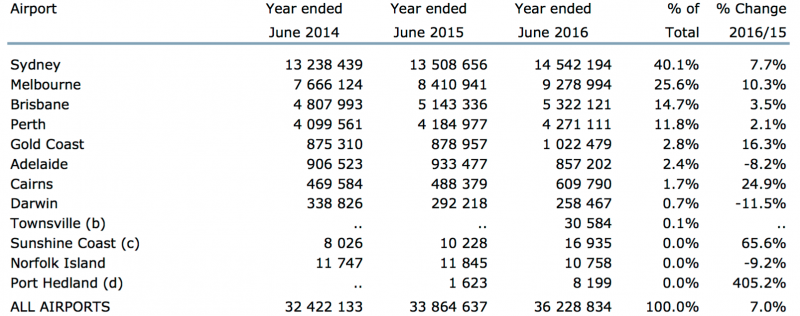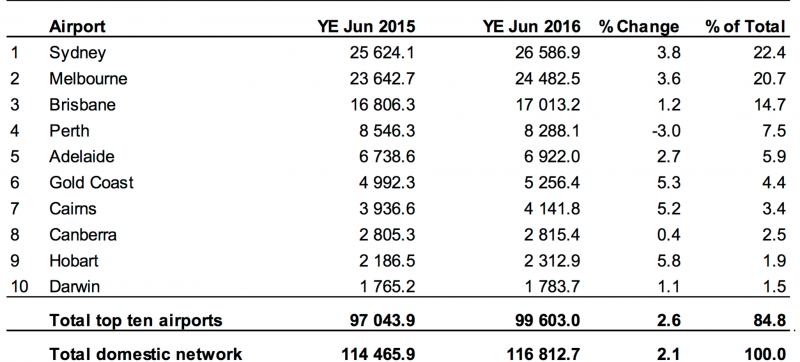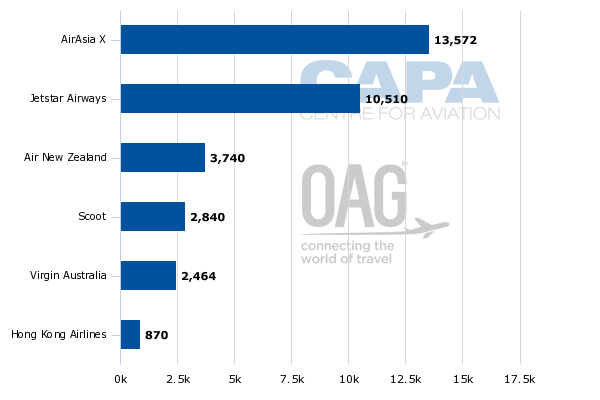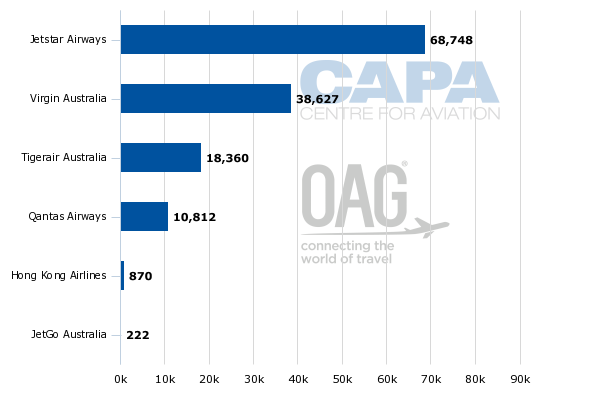Australia’s Gold Coast Airport: AirAsia X and Hong Kong Airlines drive rapid international growth
Australia's Gold Coast Airport is enjoying rapid traffic growth, driven by new and expanded international services. The airport recently started construction on a new terminal which will provide an enhanced level and service, and more widebody parking spots, to support anticipated further international growth.
Gold Coast traffic was up 8% to 6.3 million passengers in the year ending 30-Jun-2016, with international traffic up 18% to 1.05 million. Gold Coast had the fastest international growth in FY2016 among Australia's six main international airports.
AirAsia X and Hong Kong Airlines have accounted for most of the recent growth. AirAsia X has added capacity on Kuala Lumpur-Gold Coast while launching Gold Coast-Auckland. Hong Kong Airlines launched services to Gold Coast in early 2016 and is already planning to increase capacity.
- Gold Coast Airport in Australia is experiencing rapid traffic growth, driven by new and expanded international services.
- The airport recently started construction on a new terminal to support anticipated further international growth.
- Gold Coast had the fastest international growth in FY2016 among Australia’s six main international airports.
- AirAsia X and Hong Kong Airlines have accounted for most of the recent growth at Gold Coast Airport.
- Gold Coast is Australia’s sixth largest airport and reported an 18% increase in international passenger movements in FY2016.
- Gold Coast Airport is diversifying beyond low-cost carriers and is keen to attract more full-service airlines from Asia.
Gold Coast growth outpaces peers in FY2016
Gold Coast is Australia's sixth largest airport behind Sydney, Melbourne, Brisbane, Perth and Adelaide. In the fiscal year ending 30-Jun-2016 (FY2016) Gold Coast's total passenger traffic was up 7.5% to a record 6.3 million.
Gold Coast reported an 18% increase in international passenger movements to 1.05 million, and 5.6% domestic growth to 5.26 million, in the process overtaking Adelaide as sixth largest. Both growth figures were higher than those of any of Australia's other top six airports.
Average international passenger growth in Australia for FY2016 was 7%, according to Australia BITRE data. Gold Coast had the fastest international growth among the top six airports. Cairns, Sunshine Coast and Port Hedland had faster growth but on a smaller base (particularly Sunshine Coast and Port Hedland, each of which only has one international route).
Australia's international airports ranked by revenue passenger traffic and year-over-year growth: FY2016 vs FY2015
Following the capacity truce between the two major airline groups, average domestic growth in Australia in FY2016 was a more modest 2%, based on BITRE figures. Of Australia's 10 largest domestic airports only Hobart in Tasmania had slightly faster growth in FY2016 than Gold Coast. BITRE figures only include revenue scheduled passenger traffic, while airport figures typically also include non-revenue traffic and charters.
Australia's top 10 domestic airports ranked on revenue passenger traffic and year-over-year growth: FY2016 vs FY2015
Gold Coast has six airlines with international services
Gold Coast has 10 international and nine domestic routes (based on OAG data for week commencing 26-Sep-2016).
The airport is served by four foreign airlines - AirAsia X, Air New Zealand, Hong Kong Airlines and Scoot - and five local airlines - JetGo, Jetstar, Qantas, Tigerair Australia and Virgin Australia. Jetstar and Virgin Australia also have international services.
Gold Coast Airport network summary: as of 26-Sep-2016
| Total Airlines | 9 |
| Domestic only | 3 |
| International | 6 |
| Total non-stop passenger destinations | 19 |
| Domestic | 9 |
| Africa | 0 |
| Asia Pacific | 10 |
| Europe | 0 |
| Latin America | 0 |
| Middle East | 0 |
| North America | 0 |
| Total non-stop freight destinations | 0 |
| Domestic | 0 |
| Africa | 0 |
| Asia Pacific | 0 |
| Europe | 0 |
| Latin America | 0 |
| Middle East | 0 |
| North America | 0 |
| Total Airlines | 9 | |
| Domestic only | 3 | |
| International | 6 | |
| Total non-stop passenger destinations | 19 | |
| Domestic | 9 | |
| Africa | 0 | |
| Asia Pacific | 10 | |
| New Zealand | 4 | |
| Hong Kong | 1 | |
| Malaysia | 1 | |
| Fiji | 1 | |
| Singapore | 1 | |
| Japan | 1 | |
| China | 1 | |
| Europe | 0 | |
| Latin America | 0 | |
| Middle East | 0 | |
| North America | 0 | |
Auckland and Kuala Lumpur are by far the largest international destinations and have recorded strong growth in recent months. In Jun-2016 Gold Coast-Auckland traffic was up 39% to 28,532 passengers, and Gold Coast-Kuala Lumpur traffic was up 17% to 11,905 (based on BITRE data). Kuala Lumpur traffic is of course flying into and from AirAsia's hub, so that much of the real origin and destination is beyond that point.
All three of Gold Coast's other New Zealand routes - Christchurch, Queenstown and Wellington - also recorded year-over-year increases in Jun-2016. Hong Kong and Wuhan, launched over the last year, have also contributed to the recent surge in international passenger traffic.
International growth rate accelerates
International traffic has particularly surged in 1HCY2016. International traffic was up 24% in 1HCY2016, compared with only 5% for the full year in 2015. For CY2016 Gold Coast is on pace to record the fastest international growth rate since 2012, when Scoot entered the market.
Gold Coast Airport international passenger traffic: CY2008 to CY1H2016
The surge in 1HCY2016 was driven by new services from AirAsia X and Hong Kong Airlines. Hong Kong Airlines launched services to the Gold Coast in Jan-2016, while AirAsia X added a Gold Coast-Auckland sector in Mar-2016. (Previously AirAsia X only operated Kuala Lumpur-Gold Coast.)
AirAsia X and Hong Kong Airlines will continue to drive rapid international traffic growth at Gold Coast in 2HCY2016. The other four airlines with international services at Gold Coast are maintaining relatively flat capacity.
AirAsia X's Gold Coast capacity has more than tripled over the last year
AirAsia X added four weekly Kuala Lumpur-Gold Coast turnaround flights on 1-Jul-2016. The additional flights provided more local capacity between the Gold Coast and Malaysia, as some of the passengers on Auckland-Gold Coast continue to Kuala Lumpur (giving Gold Coast transit passengers, but limiting local Gold Coast-Kuala Lumpur traffic).
As CAPA has previously highlighted, the additional capacity for the Gold Coast is part of an overall focus on resuming expansion in Australia. AirAsia X, particularly, is bullish about increasing its share of the Gold Coast-China market, which it now serves with a one-stop product via Kuala Lumpur.
See related report: AirAsia X Part 2: LCC's Australian expansion could include Brisbane, Canberra, Nth Queensland
One year ago AirAsia X operated only five weekly flights to Gold Coast. It restored daily services at the end of Nov-2016 and now has 18 year-round weekly flights from Gold Coast (including 11 to Kuala Lumpur and seven to Auckland).
AirAsia X's weekly seat capacity at Gold Coast Airport has increased a remarkable 260% over the past year.
AirAsia X one-way weekly seat capacity at Gold Coast: Sep-2011 to Feb-2017
Hong Kong Airlines quickly adds capacity at Gold Coast
Hong Kong Airlines entered the Gold Coast market in Jan-2016, with seasonal charter flights for Chinese New Year. It quickly decided to upgrade its Hong Kong-Gold Coast-Cairns-Hong Kong service to a scheduled year-round twice weekly service and added a third weekly frequency in Jul-2016.
In Sep-2016 Hong Kong Airlines unveiled plans for a further increase in capacity to the Gold Coast, with five weekly year-round flights from Dec-2016 and a daily service during the Chinese New Year period in early 2017. At least for now, Hong Kong Airlines will continue to tag Gold Coast with Cairns on a circular routing.
The additional capacity from Hong Kong Airlines is significant as it enables Gold Coast to continue growing traffic from China, which is the fastest growing source market for the region's tourism sector. Hong Kong Airlines relies heavily on connections to mainland China, although most of its Australia traffic consists of individual consumers rather than group bookings.
Jetstar suspension of Wuhan should have relatively small impact
Over the past year Gold Coast has benefitted from its first regular nonstop connection with mainland China. Jetstar has operated a twice weekly scheduled charter service from Gold Coast to Wuhan since Oct-2015, backed by a Chinese agent. The Wuhan service has generated approximately 4,000 passengers per month, contributing to Gold Coast's recent rapid rate of growth.
However, Jetstar operated its last Gold Coast-Wuhan flight on 27-Sep-2016. Gold Coast should be able to attract another China route in the near future, and potentially establish a more permanent scheduled service.
Gold Coast previously handled seasonal charter flights from China Southern Airlines. Wuhan was a year-round service but was a small route, accounting for only approximately 5% of Gold Coast's monthly international traffic.
Jetstar continues to operate six international routes from Gold Coast - Auckland, Christchurch, Nadi, Queenstown, Tokyo and Wellington. However only Auckland is daily, and only Tokyo is served with widebody aircraft.
Jetstar is no longer the international market leader at Gold Coast. AirAsia X now has that distinction, accounting for approximately 40% of international seat capacity compared with 31% for Jetstar.
Gold Coast international weekly seat capacity by airline: 26-Sep-2016 to 2-Oct-2016
Gold Coast poised for further international growth
AirAsia X has been evaluating further capacity increases at the Gold Coast, including the addition of a second New Zealand route.
Gold Coast was AirAsia X's very first route when it commenced operations in late 2007. AirAsia X has established a strong brand in the Gold Coast market that it is now leveraging with the new services to Auckland. Prior to the launch of Auckland, AirAsia X's capacity at Gold Cast was relatively stable for over eight years.
Gold Coast Airport is also talking to several airlines about potential new international services. At least one new international route is likely to be announced by the end of 2016. However, Queensland Airports CEO Chris Mills told CAPA TV in an Aug-2016 interview on the sidelines of the CAPA Australia Pacific Aviation Summit that the focus at Gold Coast is mainly on growing the existing services.
Gold Coast Airport plans expansion
Gold Coast is confident that international traffic will continue to rise rapidly and is now committed to opening a new terminal in 2018. Construction on the major upgrade project began in mid-2016.
"We are bursting at the seams", Mr Mills told CAPA TV. "We just don't have enough areas to park planes, we don't' have enough gates and we have congestion at various parts of the terminal. The terminal is not coping well."
Gold Coast Airport's current single-storey structure does not have any aerobridges, and was not designed for the more than 6 million annual passengers the airport now handles - or the more than 1 million international passengers. The new building will have three stories and provide four aerobridges, as well as at least three additional widebody parking stands. More aerobridges and widebody stands are planned as part of later phases.
"It really takes us to another level", Mr Mills said. "Gold Coast Airport is a single level terminal building currently. The new terminal building will go three levels. We will have aerobridges for the first time at Gold Coast - that is something our customers have been telling us they would like to see. It will provide better amenity and better facilitation for our passengers."
Queensland Airports CEO Chris Mills discusses the rapid growth at Gold Coast Airport and airport expansion plans
An instrument landing system is also planned as a separate project, pending final approvals. Gold Coast is now the only one of the top 10 airports in Australia without an ILS.
Gold Coast diversifies beyond LCCs
The new widebody parking spots should support further long haul LCC expansion. LCCs currently account for approximately two thirds of the airport's seat capacity. Long haul LCCs (AirAsia X, Scoot and Jetstar's 787 operation) account for over 90% of Gold Coast's Asia capacity.
However, Gold Coast is keen to continue growing its full service airline capacity - both domestic and international. "Gold Coast over time has expanded and diversified so it's not just low cost", Mr Mills said. "It's a mix of low cost and full service."
The success of Hong Kong Airlines could attract other full service airlines from Asia.
Air New Zealand also serves Gold Coast from Auckland and Christchurch; its Auckland capacity is supplemented by flights operated by its trans-Tasman joint venture partner Virgin Australia.
Qantas drives domestic growth at Gold Coast
While international growth has been much faster and in the spotlight, Gold Coast has also been growing domestically. Qantas has been the biggest driver of domestic growth over the past year, with increases to both Melbourne and Sydney. Qantas resumed services to Gold Coast in Oct-2012.
Qantas' current capacity at Gold Coast is up 34% year-over-year, according to CAPA and OAG data. It currently has a 7% share of domestic capacity at Gold Cost compared with 5% a year ago.
Qantas' LCC subsidiary Jetstar remains by far the largest domestic airline at Gold Coast with a 52% share of current domestic capacity. Virgin Australia is the second largest with 26%, while its LCC subsidiary Tigerair Australia is third largest with a 14% share.
Gold Coast domestic weekly seat capacity by airline: 26-Sep-2016 to 2-Oct-2016
Gold Coast-Sydney is now the fourth largest domestic route in Australia, and Gold Coast-Melbourne is the seventh largest. Among Australia's top 10 domestic routes, Gold Coast-Melbourne had the fastest growth in FY2016 at 7.9%, while Gold Coast-Sydney had the third fastest growth at 4.6%.
Australia top 10 domestic routes ranked by annual passenger numbers: FY2016 vs FY2015
Despite the additional capacity from Qantas, and the intense competition, load factors remain high. Gold Coast-Sydney had an annual load factor of 85.4% - the highest of any of the top 50 domestic routes in Australia. Gold Coast-Melbourne had an annual load factor of 82.6%, well above the domestic average.
Gold Coast Airport's outlook appears bright - with long haul LCCs the main drivers
Gold Coast is likely to remain one of the fastest growing airports in Australia.
The Gold Coast is one of Australia's most popular tourist destinations - both for domestic and international travel. It also benefits from local economic and population growth.
The new terminal and expanded apron are necessary steps as Gold Coast prepares for further growth.
While the terminal will make the airport more appealing to full service airlines considering the destination, including from mainland China, the biggest opportunities remain in the emerging long haul low cost sector.






